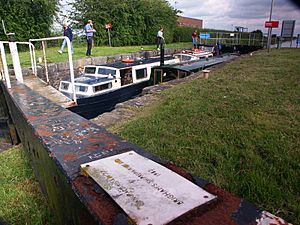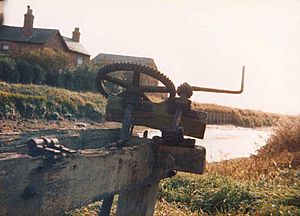Struncheon Hill Lock facts for kids
The Struncheon Hill Lock is an important part of the Driffield Navigation in the East Riding of Yorkshire, England. It was added later to help boats move easily along the water, especially when the tide was low. This lock is the very first one you meet on the navigation. Sometimes, people call it "Top Hill Low" because there's a big water pumping station nearby with that name.
Contents
Where is Struncheon Hill Lock?
This lock is located close to a tiny village called Hempholme. It's about 1.2 kilometers (0.75 miles) south of Bethells Bridge. You can get to the lock by walking along a path from Hempholme. Another way is through the waterworks area at Top Hill Low, which is also a cool nature reserve.
The lock is found on the Driffield Navigation:
- The next place upstream is Bethells Bridge.
- The next place downstream is Wilfholme Landing.
How Was Struncheon Hill Lock Built?
Between 1803 and 1811, big improvements were made to the navigation. During this time, a new shortcut was dug for the river around Struncheon Hill. This shortcut helped boats avoid a long, winding bend in the River Hull.
William Chapman was in charge of these building projects. He made the lock the same size as others on the navigation. It was designed for boats up to 18.3 meters (60 feet) long and 4.4 meters (14 feet 6 inches) wide. This size was perfect for boats called Yorkshire Keels. However, it turns out the lock was actually built a bit longer! In 2009, a boat named Victoria, which was 21.8 meters (71.5 feet) long, managed to get through. It could only fit when pointing upstream because the water wasn't deep enough over the bottom edge of the lock.
How the Lock Changed Over Time
The lock was first built with just one chamber. But like another lock called Snakeholme, engineers soon realized that at low tide, boats couldn't get over the bottom edge. So, a second chamber was added! To empty this lower chamber, a big hole was made in one of the lock walls, and a wooden gate (called a sluice) was used. The water from the upper lock would then fill the lower one.
Originally, the lock had strong oak gates that were opened using long wooden levers called handspikes. Later, the top gates were replaced with unusual steel ones by Yorkshire Water, a company that managed the navigation for drainage and water supply. Instead of balance beams, these new gates had a complex gear system that pulled them open with a special crank tool called a windlass. The water gates (paddles) were designed like those used in weirs and took many turns to open.
A weir, which is like a small dam, was also built at the lock to control the river's water level. Around the same time the top gates were replaced, the weir was updated with an automatic control system. There's a small building next to the weir that holds equipment to measure water levels and control the weir. It used to have a glass window where you could see a paper roll recording the water level, but it's now bricked up to prevent damage.
The area around the weir is a popular spot for fishing. You can find fish like perch, gudgeon, and pike there.
In 1982, the bottom gates were replaced with new steel ones by the Driffield Navigation Amenities Association. These new gates had balance beams, making them easier to open. To save money, they used a simpler screw-style system for the paddles.
Just below the lock, there was once a pumping station that used steam power to lift drain water into the river. Later, the steam engine was replaced with diesel engines, but the old boilers were left inside the building. The entire pumping station was finally taken down in the late 1980s.
Images for kids





